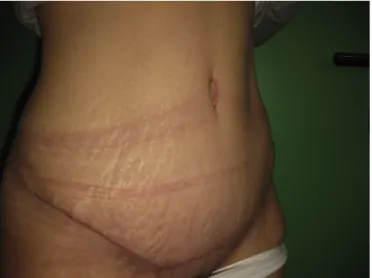CASE
REPORT
–
OPEN
ACCESS
InternationalJournalofSurgeryCaseReports47(2018)100–103
ContentslistsavailableatScienceDirect
International
Journal
of
Surgery
Case
Reports
jo u r n al ho me p a g e :w w w . c a s e r e p o r t s . c o mAbdominoplasty
with
“Scarpa
Fascia”
preservation:
Case
Report
Antonio
Iannelli
a,
Francesco
Ciancio
a,∗,
Paolo
Annoscia
a,
Michelangelo
Vestita
a,
Rosario
Emanuele
Perrotta
b,
Giuseppe
Giudice
a,
Michele
De
Robertis
caDepartmentofPlasticandReconstructiveSurgery,UniversityofBari,Italy bDepartmentofPlasticandReconstructiveSurgery,UniversityofCatania,Italy cU.O.ChirurgiaPlastica–OspedaleMadonnadelleGrazie,Matera,Italy
a
r
t
i
c
l
e
i
n
f
o
Articlehistory:
Received6February2018 Accepted29April2018 Availableonline9May2018
Keywords: Abdominoplasty Tummytuck ScarpaFascia Weightloss Seroma Lipectomy
a
b
s
t
r
a
c
t
INTRODUCTION:AbdominoplastyisoneofthemostperformedoperationsinPlasticSurgeryintheworld.
Postoperativeseromaisoneofthemostfrequentlycitedcomplicationsinliterature.Theaimofthisstudy
istoproposeourexperiencewithabdominoplastywithScarpaFasciapreservationandcompareitwith
recentscientificliterature.
PRESENTATIONOFCASE:Wepresentthecaseofa55-year-oldwomanunderwentbariatricsurgeryin
2014,afterwhichshelost55kgofweight.Wedecidedtoperformanabdominoplastywithtransposition
oftheumbilicusandpreservationoftheScarpaFascia.Infact,thistechniqueseemstohaveapositive
impactonreducingseromaformation,reducingtheamountofdrainedfluidsandthedrainagetime.
DISCUSSION:Thesavingoftheadipose-fasciallayeraccordingtodifferentAuthorswouldallowthe
reductionofthevolumeofdrainedfluid,ofthetimespentbythedrainsandtheaveragehospitalstay.
CONCLUSION:TheabdominoplastywiththeScarpaFasciapreservationisasafe,repeatabletechnique
withgoodaestheticresults.Thesavingofdeepadiposetissueallowstoreducethetimeandthequantity
ofdrainedliquids.Inourexperiencepatientundergoingthistechniquehasshorterhospitalstayswith
nocomplications.
©2018PublishedbyElsevierLtdonbehalfofIJSPublishingGroupLtd.Thisisanopenaccessarticle
undertheCCBY-NC-NDlicense(http://creativecommons.org/licenses/by-nc-nd/4.0/).
1. Introduction
Abdominoplastyis oneof themostperformedoperations in PlasticSurgeryintheworld[1].Severalsurgicaltechniqueshave beenproposedover theyearsand,especiallyinthelastdecade, therehasbeenaremarkableevolutionofthisprocedure[2–3]. Post-operativeseromaisoneofthemostfrequentlycitedcomplications inliteratureandinrecentyearstheadvantageofpreservationofthe ScarpaBelthasbeenincreasinglyaffirmed[4–5].Infact,the sav-ingofdeepadiposetissue,intheinfra-umbilicalarea,wouldallow asavingofvascularandlymphaticstructureswithareductionin seromaformation,areductionintimeandquantityofdrainageand areductioninhospitalstaytime.Despitethefactthatforseveral yearsnowa reductionofthesevariableshasbeenaffirmed,few jobshavebeenabletoleadtoanunambiguousinterpretationof theeffectsofthistechnique,sothatitisstillnecessarytocarryout studiesonlargesamples.
Theaimofthis studyistopropose ourexperiencewiththis techniqueandcompareitwithrecentscientificliterature.Thework hasbeenreportedinlinewiththeSCAREcriteria[6].
∗ Correspondingauthorat:DepartmentofPlasticandReconstructiveSurgery,CAP 70124,PiazzaGiulioCesare11,Bari,Italy.
E-mailaddress:[email protected](F.Ciancio).
2. Casereport
We present the case of a 55-year-old woman underwent bariatric surgery in 2014, after which shelost 55kgof weight (Fig.1).Thepatientdidnothaveassociatedco-morbidities.Given thesignificantweightloss,witha stablebodyweightforabout 1year,thepatientshowedacommonskinlaxity,especially rep-resented in the abdominal region. The cutaneous laxity of the abdominalregion,withptosisofthedermo-adiposetissues, clas-sifiedthepatientasagrade3accordingtoMatarasso[7],alsohad adiastasisoftherectusmusclesoftheabdomen,withindication for surgical intervention. We decide to perform an abdomino-plastywithtranspositionof umbilicusand strengtheningofthe rectus abdominis muscles by plication of the muscular fascia. Givenourexperiencewithpatientsundergoingbariatricsurgery, wedecidedtoperformanabdominoplastywithpreservationof theScarpaFascia. In fact,this technique seemstohavea posi-tiveimpactonreducingseromaformation,reducingtheamount ofdrainedfluidsandthedrainagetime.Inourexperience,patients undergoingmassiveweightlossshowagreatertendencyinthe formationofseromasforwhichitisdecidedtoconductthis proce-dure.
https://doi.org/10.1016/j.ijscr.2018.04.038
2210-2612/©2018PublishedbyElsevierLtdonbehalfofIJSPublishingGroupLtd.ThisisanopenaccessarticleundertheCCBY-NC-NDlicense(http://creativecommons.
CASE
REPORT
–
OPEN
ACCESS
A.Iannellietal./InternationalJournalofSurgeryCaseReports47(2018)100–103 101
Fig.1. Pre-operativephoto.
Weevaluatedthefollowingvariables:age,BMI,comorbidity, drainageremovaltimes,totalvolumeofdrainedfluids,lengthof hospitalstay.Thefollow-upwas18months.
3. Surgicaltechnique
Inourclinicalpractice,weperformantibioticprophylaxiswith cefazolin2giv30minbeforesurgery.Accordingtotheliterature [4–5] theabdominal flapwassculpted in two differentplanes, superficialprefascial(abovetheScarpaFascia)intheinfraumbilical regionandpreaneuroticregionintheepigastricportion.Theskin incisionismadeaccordingtothepreoperativedesign[8](Fig.2), thentheabdominalflapissculptedwithultrasoundscalpels. Dur-ingthismaneuverwepreferamanualtractionoftheflaptakingcare topreservetheScarpaFasciauptoabout1cmbelowthe umbili-calscarasdescribedintheliterature.Oncethislevelisreached, dissectioniscarriedoutaccordingtoapremuscular (preaponeu-rotic)plane.Thedissectionuptothexiphoidprocessisconfined totheareabetweenthemedialmarginsoftherectusabdominis musclesinordertopreservetheperforatingvesselsoftheupper abdomen.Thetrabecularligamentofthexyphoidprocess,inour case hasbeensectionedsothesliding ofthe abdominalflapis facilitated.Oncethetunnelhasbeencompleted,themusclefascia oftherectumisplicatedwithitsapproachintheupper abdom-inalportions,thena medialportionoftheadipofascialtissue is removedandthepremuscularplaneisexposed(Fig.3).Reposition oftheumbilicalscarapproximately2cmabovetheprojectionon theabdominalflap.Withthepatientinsemi-Fowlerpositionthe abdominalflapisapproachedatthesuprapubicmarginand posi-tioningof2suctiondrainsJP(JacksonPratt).Suturesin3layersin latero-medialdirectionanddressingwithsteri-strip.Thepatient
Fig.2. Intra-operativephoto. Wecan distingueetwodifferentsurgicalplane: superficialprefascial(abovetheScarpaFascia)intheinfraumbilicalregionand preaneuroticregionintheepigastricportion.
Fig.3. Plicationoftherectusoftheabdomen.Theadipose-fascialtissueexeresisis notedalongthemidlineoftherectusabdominis.
wore a compressive sheath for 40 days. Drains were removed in seconddaywhen theamount drainedin 24hwasless than 30ml.
4. Discussionandconclusion
theabdominoplastywithtranspositionoftheumbilicusisone ofthemostperformedsurgicalproceduresinPlasticSurgery[1–9]. Severalsurgicalstrategieshavebeendescribedinliteratureto reducetherateof complicationsof traditionalabdominoplasty: selectivedissection,theuseofclosedsuctiondrains,avoidtheuse ofelectrocautery whennecessary,bindthepiercingvessels,the useofnegativepressure,sclerotherapy,theuseoffibringlueand delayedmobilization[10–14].Theseromarepresentsthe compli-cationmostpresentintheliteraturealsocomingtoratesof40% [4–5].
Over the last few years the technique with preservation of theScarpaFasciahasarousedconsiderableinterestinthe litera-ture.ThistechniquehasbeendescribedbyLouarnwhosuggests avoidingthedissectionexclusivelyonthepremuscular planeof therectusoftheabdomenbutpreservingthefasciainthe infra-umbilical region [15].The subcutaneous tissue structure of the
CASE
REPORT
–
OPEN
ACCESS
102 A.Iannellietal./InternationalJournalofSurgeryCaseReports47(2018)100–103
Fig.4. Photographiccontrolafter45days.
abdominalwall comprises two distinct adipose,superficial and deeplayersseparatedbytheScarpaFascia[16–17]Inthis proce-durehasbeenpreservedandwithitalsothedeepadiposetissue, withtherespectivelymphaticvessels,arteriesand veins. Prob-ablythesavingofdeepadipose-fascialtissueis thekeystonein reducing therate ofcomplications related to seroma and lym-phaticdrainageintummytuckwithtranspositionoftheumbilicus. Theabdominalwall,infact,hastwodifferentareasoflymphatic drainage,dividedanddefinedbya horizontalplaneatthelevel oftheumbilicalregion:theepigastricareadrainstothearmpits andthehypogastricareadrainstotheinguinalregions.The inci-sionperformedin this techniquenot interrupt theconnections betweenthedeepadiposetissueandtheinguinallymphatic sta-tions.
The saving of the adipose-fascial layer according to differ-entAuthorswouldallowthereductionofthevolumeofdrained fluid,of thetime spent bythedrains and theaveragehospital stay[4–5].Inourcase weobservedashorter hospitalstay time than conventionallyabdominoplasty, in fact in clinicalpractice we preferto discharge patientswithoutdrainage, ie when the volumeofliquiddrainedin 24hisless than30mlalternatively weremovethedrainagenolaterthan thetenthday.Giventhe loweramountoffluidsdrainedinpatientundergoing abdomino-plastywithScarpaFasciasavings,weremovedthedrainsabout 3 daysearlier than classical procedurewithout preservation of ScarpaFascia,withshorter hospitalizationtimes.Thisfactorhas beenoneoftheelementsthathasallowedustoreducethecosts relatedtohospitalization anddeservesfurthereconomic-health study.
TheabdominoplastywiththeScarpaFascia preservationis a safe,repeatabletechniquewithgoodaestheticresults(Fig.4).The savingofdeepadiposetissueallowstoreducethetimeandthe quantityofdrainedliquids.Inourexperiencepatientundergoing thistechniquehasshorterhospitalstayswithnocomplications. Theindicationfor theuseofthis technique isin thedefinition phasebutitisabsolutelyavalidalternativeincasesof abdomino-plastywithtranspositionoftheumbilicus.Itcouldbeinteresting totrytoidentifythepatient ¨model¨thatcanbeappliedtothis tech-nique.
Conflictsaveapositiveimpactonreducingseromofinterest Theauthorshavenoconflictsofinteresttodisclose
Fundingsources
Authorshavenotreceivedfundingorsponsorforpaper produc-tion
Ethicalapproval
Tocarryoutthisscientificwork,therewasnoneedtoresort totheethicscommittee.Ethicalapprovalhasbeenexemptedfrom ourinstitution.
Consent
Writteninformedconsentwasobtainedfromthepatientfor publicationofthiscasereportandaccompanyingimages.Acopy ofthewrittenconsentisavailableforreviewbytheEditor-in-Chief ofthisjournalonreques
Authorcontribution CiancioFrancescowriting PaoloAnnosciawriting AntonioIannelliDatacollection
ProfPerrottaRosarioEmanuelecoordinator ProfGiuseppeGiudicecoordinator
MicheleDeRobertisSurgeonOperator Registrationofresearchstudies
Notnecessary Guarantor
FrancescoCiancioMD References
[1]A.Matarasso,etal.,Abdominoplastyandabdominalcontoursurgery:a
nationalplasticsurvey,PlastReconstr.Surg.1(17)(2006)1797.
[2]S.O.Sozer,F.J.Agullo,A.A.Santillan,C.Wolf,Decisionmakingin
abdominoplasty,AestheticPlastSurg.31(2007)117–127.
[3]J.B.Heller,E.Teng,B.I.Knoll,J.Persing,Outcomeanalysisofcombined
lipoabdominoplastyversusconventionalabdominoplasty,PlastReconstr.
Surg.12(1)(2008)1821–1829.
[4]A.Costa-Ferreira,M.Rebelo,etal.,Scarpafasciapreservationduring
abdominoplasty:aprospectivestudy,PlastReconstr.Surg.1(25)(2010)1232.
[5]R.C.Fang,S.J.Lin,etal.,Abdominoplastyflapelevationinamoresuperficial
plane:decreasingtheneedfordrains,PlastReconstr.Surg.1(25)(2010)677.
[6]R.A.Agha,A.J.Fowler,A.Saetta,I.Barai,S.Rajmohan,D.P.Orgill,fortheSCARE
Group,TheSCAREstatement:consensus-basedsurgicalcasereport
guidelines,Int.J.Surg.(2016).
[7]A.Matarasso,Abdominoplasty:asystemofclassificationandtreatmentfor
combinedabdominoplastyandsuction-assistedlipectomy,AestheticPlast
Surg.15(1991)111–121.
[8]J.A.Friedland,T.R.Maffi,MOC-PS(SM)CMEarticle:abdominoplasty,Plast
Reconstr.Surg.121(4Suppl)(2008)1–11.
[9]AmericanSocietyofPlasticandReconstructiveSurgeons,2000/2006/2007
NationalPlasticSurgeryStatistics:CosmeticandReconstructiveProcedure
Trends,Availableat:http://www.plasticsurgery.org.AccessedJanuary17,
2009,2009.
[10]O.R.Saldanha,E.B.DeSouzaPinto,W.N.Mattos,etal.,Lipo-abdominoplasty
withselectiveandsafeundermining,Aes-TheticPlastSurg.27(2003)
322–327.
[11]T.Pollock,H.Pollock,Progressivetensionsuturesinabdominoplasty,Clin.
PlastSurg.31(2004)583–589.
[12]N.Toman,A.Buschmann,T.Muehlberger,Fibringlueandseromaformation
followingabdominoplasty(inGerman),Chirurg78(2007)531–535.
[13]A.Stoff,M.A.Reichenberger,D.F.Richter,Comparingtheul-trasonically
activatedscalpel(harmonic)withhigh-fre-quencyelectrocauteryfor
postoperativeserousdrainageinmassiveweightlosssurgery,PlastReconstr.
Surg.120(2007)1092–1093.
[14]I.Petrakis,S.Xenaki,A.Andreou,G.Panagiotakis,G.Chalkiadakis,Therapeutic abdominoplasty:reportofacase,InternationalJ.Surg.CaseReports8(2015) 96–99,http://dx.doi.org/10.1016/j.ijscr.2015.01.039.
CASE
REPORT
–
OPEN
ACCESS
A.Iannellietal./InternationalJournalofSurgeryCaseReports47(2018)100–103 103
[15]C.LeLouarn,Partialsubfascialabdominoplasty:ourtechniqueaproposof36
cases,Ann.Chir.PlastEsthet.37(1992)547–552.
[16]B.Markman,F.E.BartonJr,Anatomyofthesubcutaneoustissueofthetrunk
andlowerextremity,PlastReconstr.Surg.80(1987)248–254.
[17]M.Guida,A.Cramarossa,E.Fistola,M.Porcelli,G.Giudice,K.Lubello,G.
Colucci,Highactivityofsequentiallowdosechemo-modulating
temozolomideincombinationwithfotemustineinmetastaticmelanoma.A
feasibilitystudy,J.Transl.Med.10(November(8))(2010)115.
OpenAccess
ThisarticleispublishedOpenAccessatsciencedirect.com.ItisdistributedundertheIJSCRSupplementaltermsandconditions,which permitsunrestrictednoncommercialuse,distribution,andreproductioninanymedium,providedtheoriginalauthorsandsourceare credited.

